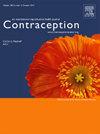在美国获得米非司酮和米索前列醇以及仅米索前列醇远程医疗药物流产服务的人的特点。
IF 2.3
2区 医学
Q1 OBSTETRICS & GYNECOLOGY
引用次数: 0
摘要
目的:本研究比较了美国使用米非司酮/米索前列醇和仅使用米索前列醇的远程医疗药物流产方案的患者的特点。研究设计:我们提取并分析了2020年4月27日至2022年5月31日期间使用虚拟诊所的所有客户的特征。我们比较使用米非司酮和米索前列醇或仅使用米索前列醇的患者的社会人口学特征。我们进行了多变量分析,以确定与使用每种方案相关的特征。结果:分析样本包括8790例患者:84%使用米非司酮和米索前列醇,16%使用米索前列醇。大多数客户(54%)年龄在26-35岁之间。受教育年限较短、生活在大西洋中部或中西部、收入较低的特征与仅使用米索前列醇呈正相关。认为自己是白人或非黑人或白人的种族特征,以及具有较高的教育水平和报告较高的收入,与使用米非司酮/米索前列醇呈正相关。虽然没有直接测试,但相关特征表明,方案价格的差异可能会影响方案的使用。结论:研究结果显示了远程医疗药物流产的人群范围,并表明使用米非司酮/米索前列醇和仅使用米索前列醇的客户之间存在一些差异。启示:由于米非司酮继续受到限制,远程医疗流产在美国提供的药物流产中所占的份额越来越大,这些研究结果为考虑扩展到远程医疗以提供仅使用米索前列醇方案的诊所提供了服务。研究结果还为旨在提高服务可负担性的扩大政策提供了信息,包括扩大私营、公共和医疗补助保险计划的覆盖范围。本文章由计算机程序翻译,如有差异,请以英文原文为准。
Characteristics of people obtaining mifepristone and misoprostol and misoprostol-only telehealth medication abortion services in the United States
Objectives
This study compares the characteristics of people using mifepristone/misoprostol and misoprostol-only telehealth medication abortion regimens in the United States.
Study design
We abstracted and analyzed characteristics for all clients using a virtual clinic between April 27, 2020, and May 31, 2022. We compare sociodemographic characteristics between clients who used either mifepristone and misoprostol or misoprostol only. We conducted multivariable analyses to identify characteristics associated with using each regimen.
Results
The analytic sample included 8790 clients: 84% used mifepristone and misoprostol, and 16% used misoprostol only. Most clients (54%) were aged 26 to 35 years. Characteristics of having fewer years of education, living in the Mid-Atlantic or Midwest, and reporting a lower income were positively associated with using misoprostol only. Characteristics of identifying as White or a race other than Black or White, as well as having higher levels of education and reporting a higher income, were positively associated with using mifepristone/misoprostol. Although not directly tested, associated characteristics indicate that a difference in regimen price may have influenced regimen use.
Conclusions
Findings demonstrate the range of people who have telehealth medication abortions and suggest some differences between clients who used mifepristone/misoprostol and clients who used misoprostol only.
Implications
As mifepristone continues to be restricted and telehealth abortions are a growing share of the medication abortions provided in the United States, these findings inform service delivery for clinics considering expanding into telehealth to provide misoprostol-only regimens. Findings also inform expanding policies aimed at the affordability of services, including expanding coverage from private, public, and Medicaid insurance programs.
求助全文
通过发布文献求助,成功后即可免费获取论文全文。
去求助
来源期刊

Contraception
医学-妇产科学
CiteScore
4.70
自引率
17.20%
发文量
211
审稿时长
69 days
期刊介绍:
Contraception has an open access mirror journal Contraception: X, sharing the same aims and scope, editorial team, submission system and rigorous peer review.
The journal Contraception wishes to advance reproductive health through the rapid publication of the best and most interesting new scholarship regarding contraception and related fields such as abortion. The journal welcomes manuscripts from investigators working in the laboratory, clinical and social sciences, as well as public health and health professions education.
 求助内容:
求助内容: 应助结果提醒方式:
应助结果提醒方式:


